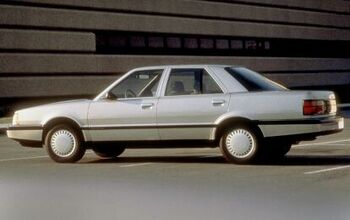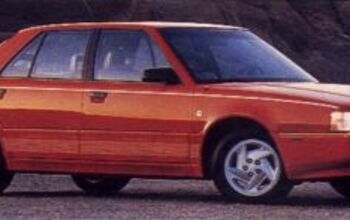Rare Rides: The Eagle Premier Story, Part IV

Today is the fourth installment in our Eagle Premier series. Parts I, II, and III brought us through late 1987 when the Premier finally entered production, albeit well behind schedule.
The Renault group’s high profile chairman had been assassinated in fall 1986 by French extremists, and the company’s new chair, Raymond Lévy, was experiencing pressure from all sides.
And the Premier was largely responsible for said pressure, with its lengthy development and expensive new assembly plant in Ontario. AMC on its own lost $91.3 million in 1986, which worsened Renault’s already tenuous financial situation. Lévy’s predecessor had embarked on austerity measures across the Renault portfolio starting in 1985. Factories closed, and many jobs were lost in France while money poured into North America. Lévy continued these initiatives through 1987, and by then the company had stabilized financially to an extent.
However, Renault was still losing money domestically. Across the ocean, AMC was seen as a money pit by Renault executives, and its operations were losing money too. Lévy was not a huge AMC fan like his predecessor, so in considering the financial situation, the unfriendly political climate at home, and the recent assassination, he decided to sell off AMC and North American operations.
Selling AMC seemed the best way forward, as the entire situation was not a great look in France. The action would cut off a big liability to Renault’s finances, please the brass at Renault, and ease tensions with French workers. At the time Renault owned 46.1 percent of AMC’s stock. A handy buyer was found in Chrysler, who already had an agreement with AMC to produce the M-body Diplomat and Fifth Avenue at Kenosha. The existing relationship made negotiations between Chrysler and AMC-Renault easier, and the rumor mill of a Chrysler purchase of AMC had started up in 1985.
The sale agreement was set up on March 9th, 1987. Chrysler agreed to buy Renault’s stake in AMC, plus all other outstanding shares. The deal totaled $1.5 billion ($3.4 billion adj.). Unlike other mergers where lip service is generally paid to “keeping the company whole,” Chrysler was upfront about its reason for the AMC purchase. Lee Iacocca told the LA Times a day after the announcement, “For Chrysler, the attractions are Jeep, the best-known automotive name in the world…” and went on to cite the Brampton Assembly plant, and the AMC dealership network to expand Chrysler’s existing network. Of prime attractiveness to Iacocca was the (ZJ) Grand Cherokee, then well under development at AMC. Shrewd forward thinking there.
The sale didn’t close until the first week of August 1987, when the final piece of the puzzle fell into place: AMC shareholders approved (overwhelmingly) the Chrysler buyout. The fourth-largest US automaker became a subsidiary of Chrysler, and The Big Three remained. As soon as the sale closed, AMC was immediately rebranded as the Jeep-Eagle division. Chrysler separated the valuable Jeep name from a new Eagle brand that would sell a mishmash of products – including the Premier. The AMC brand was just damaged goods.
The Eagle decision was a last-minute one. That much was evident in the promotional materials distributed to dealers, which showed the Premier with Renault badges. A poster on the wall says “1988 Premier” but not Eagle. The internet assures no Premiers ever left dealer lots with Renault badges intact, but even the MotorWeek review featured a Renault-badged car.
Hastily cobbled, the Eagle brand launched in 1988 with the Premier as its flagship. But with new parentage came new product ideas (and overlap), and a new focus. More on that next time.
[Image: Chrysler]

Interested in lots of cars and their various historical contexts. Started writing articles for TTAC in late 2016, when my first posts were QOTDs. From there I started a few new series like Rare Rides, Buy/Drive/Burn, Abandoned History, and most recently Rare Rides Icons. Operating from a home base in Cincinnati, Ohio, a relative auto journalist dead zone. Many of my articles are prompted by something I'll see on social media that sparks my interest and causes me to research. Finding articles and information from the early days of the internet and beyond that covers the little details lost to time: trim packages, color and wheel choices, interior fabrics. Beyond those, I'm fascinated by automotive industry experiments, both failures and successes. Lately I've taken an interest in AI, and generating "what if" type images for car models long dead. Reincarnating a modern Toyota Paseo, Lincoln Mark IX, or Isuzu Trooper through a text prompt is fun. Fun to post them on Twitter too, and watch people overreact. To that end, the social media I use most is Twitter, @CoreyLewis86. I also contribute pieces for Forbes Wheels and Forbes Home.
More by Corey Lewis
Latest Car Reviews
Read moreLatest Product Reviews
Read moreRecent Comments
- Master Baiter I told my wife that rather than buying my 13YO son a car when he turns 16, we'd be better off just having him take Lyft everywhere he needs to go. She laughed off the idea, but between the cost of insurance and an extra vehicle, I'd wager that Lyft would be a cheaper option, and safer for the kid as well.
- Master Baiter Toyota and Honda have sufficient brand equity and manufacturing expertise that they could switch to producing EVs if and when they determine it's necessary based on market realities. If you know how to build cars, then designing one around an EV drive train is trivial for a company the size of Toyota or Honda. By waiting it out, these companies can take advantage of supply chains being developed around batteries and electric motors, while avoiding short term losses like Ford is experiencing. Regarding hybrids, personally I don't do enough city driving to warrant the expense and complexity of a system essentially designed to recover braking energy.
- Urlik You missed the point. The Feds haven’t changed child labor laws so it is still illegal under Federal law. No state has changed their law so that it goes against a Federal child labor hazardous order like working in a slaughter house either.
- Plaincraig 1975 Mercury Cougar with the 460 four barrel. My dad bought it new and removed all the pollution control stuff and did a lot of upgrades to the engine (450hp). I got to use it from 1986 to 1991 when I got my Eclipse GSX. The payments and insurance for a 3000GT were going to be too much. No tickets no accidents so far in my many years and miles.My sister learned on a 76 LTD with the 350 two barrel then a Ford Escort but she has tickets (speeding but she has contacts so they get dismissed or fine and no points) and accidents (none her fault)
- Namesakeone If I were the parent of a teenage daughter, I would want her in an H1 Hummer. It would be big enough to protect her in a crash, too big for her to afford the fuel (and thus keep her home), big enough to intimidate her in a parallel-parking situation (and thus keep her home), and the transmission tunnel would prevent backseat sex.If I were the parent of a teenage son, I would want him to have, for his first wheeled transportation...a ride-on lawnmower. For obvious reasons.


































Comments
Join the conversation
Unlike Taurus it looks dated.
Not to be a spoiler, but the Premier became an important car for Chrysler in ways they did not anticipate immediately. Chrysler bought AMC for Jeep and Brampton, but got much more.